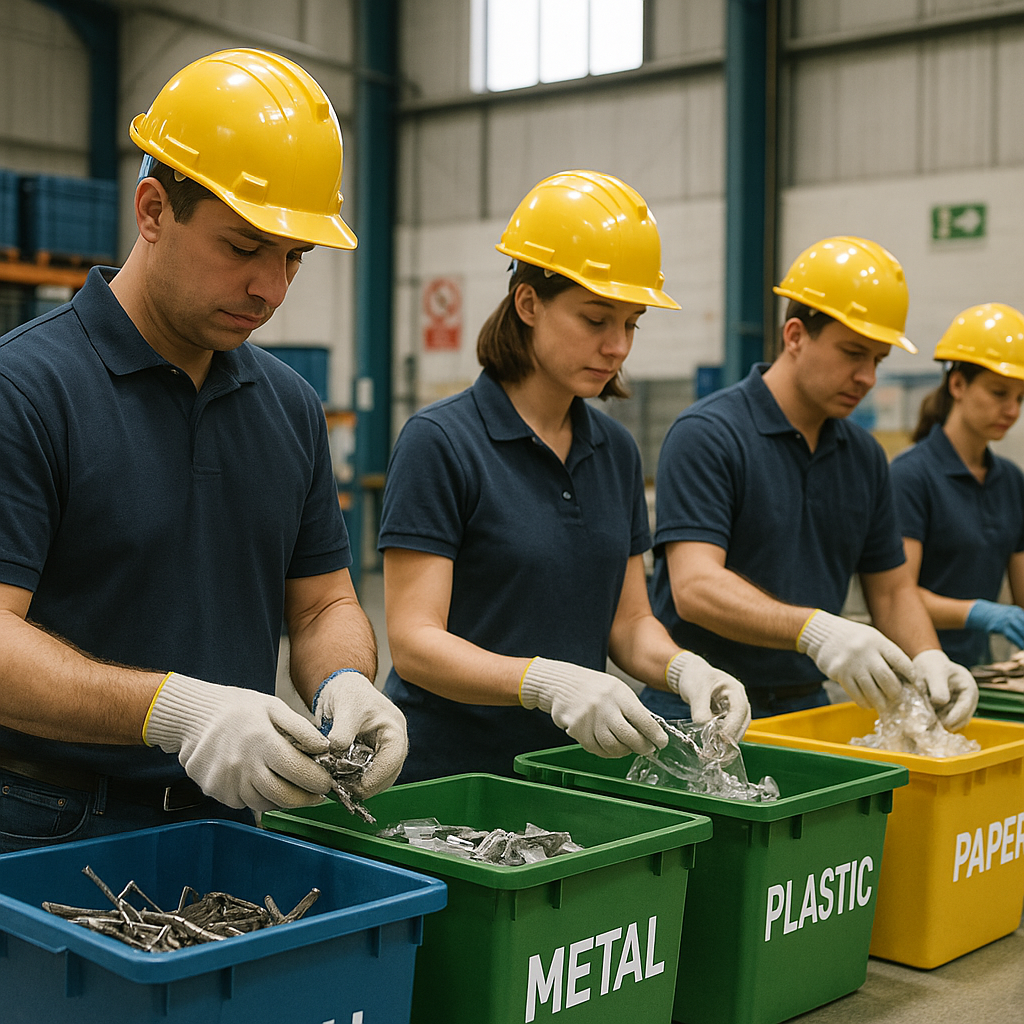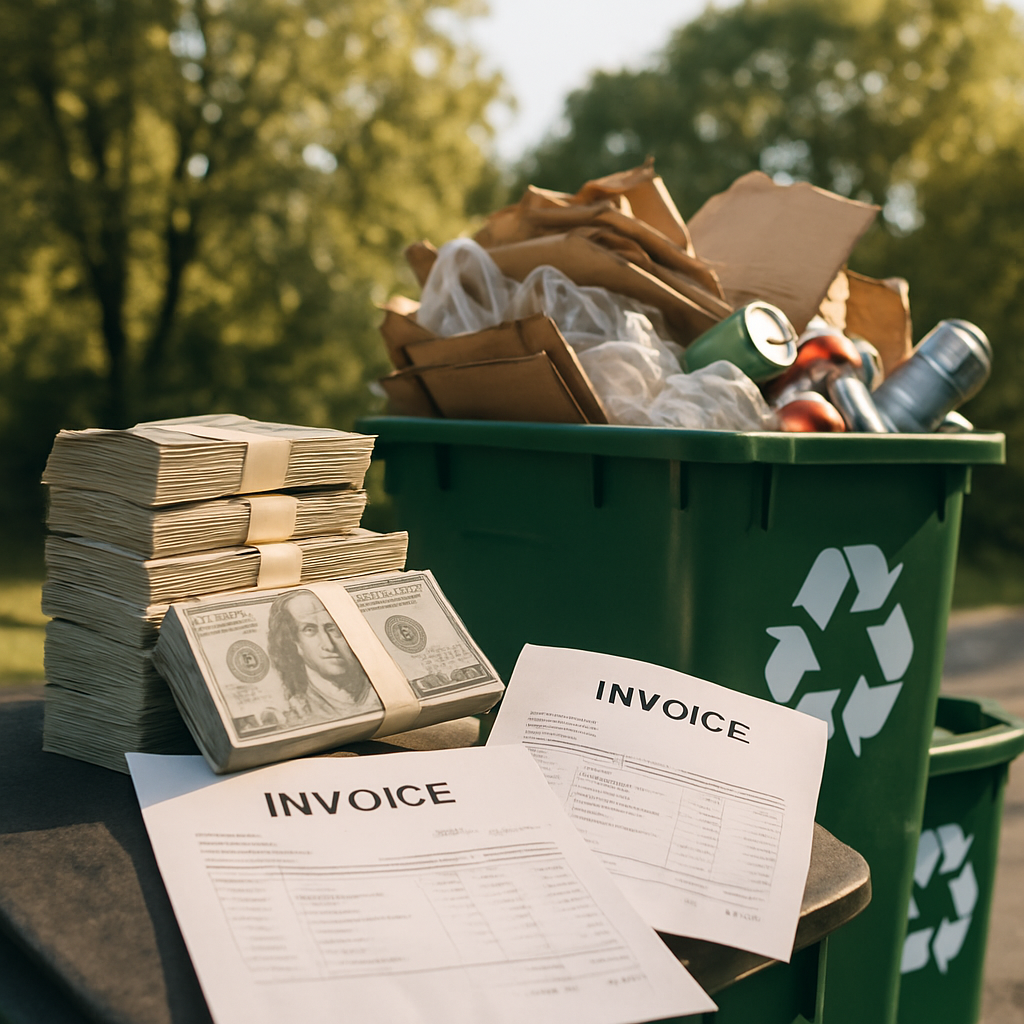5901 Botham Jean Blvd, Dallas, TX 75215
Scrap Management for Businesses: A Quick Overview for
August 14, 2025Every manufacturing, construction, and industrial operation generates waste. But what if that waste could become a valuable resource? Scrap management makes this possible for businesses across all sectors. At its core, scrap management involves the systematic process of collecting, sorting, processing, and recycling materials left over from business operations.
These materials include metal scraps, wood remnants, plastic byproducts, and paper waste. The practice goes beyond simple waste disposal to create comprehensive systems that convert discarded materials into usable resources. Effective scrap management represents both an environmental responsibility and a strategic business advantage.
In our resource-conscious economy, companies that implement structured scrap management programs gain significant benefits. They reduce operational costs, comply with increasingly strict environmental regulations, and often find new revenue streams from materials previously treated as waste.
What Are the Key Components of Effective Scrap Management?

Effective scrap management is essential for reducing waste, increasing revenue, and promoting environmental sustainability. When done correctly, it creates value from materials that might otherwise end up in landfills. Let’s explore the critical components that make up a successful scrap management system.
Material Sorting and Segregation
Proper sorting of scrap materials is the foundation of effective management. This process ensures materials maintain their value and can be efficiently recycled or reused.
Materials should be sorted by type, including ferrous metals (containing iron), non-ferrous metals (like aluminum, copper, and brass), plastics, and other recyclables. Segregation prevents contamination, which can decrease the value of your scrap and complicate processing.
Some best practices for material sorting include:
- Setting up designated collection points with clearly labeled bins throughout your facility
- Training staff to identify different types of metals and materials
- Implementing color-coded containers for different scrap categories
- Conducting regular inspections to ensure sorting compliance
Strategic Partnerships with Scrap Metal Buyers
Building relationships with established scrap metal buyers is crucial for maximizing the value of your scrap materials. These partnerships ensure you receive fair market prices and reliable service.
When selecting a scrap metal buyer, consider factors such as:
- Reputation and longevity in the industry
- Transparent pricing policies and competitive rates
- Convenient pickup services or drop-off locations
- Ability to handle various types and volumes of scrap
- Proper licensing and environmental compliance
Regular communication with your scrap metal buyer can also provide valuable insights into market trends and help adjust your scrap management strategies accordingly.
Comprehensive Waste Management Plan
A well-structured waste management plan serves as a roadmap for your scrap handling processes. This plan should outline procedures for collecting, storing, and disposing of all scrap materials generated by your operations.
Key elements of an effective waste management plan include:
- Clear guidelines for identifying and separating recyclable materials
- Procedures for safely handling and storing scrap until collection
- Documentation requirements for tracking scrap volumes and values
- Regular review and adjustment processes to improve efficiency
- Compliance measures with relevant environmental regulations
Your plan should assign specific responsibilities to team members, ensuring everyone knows their role in the scrap management process. Regularly revisiting and updating the plan keeps it relevant as operations or regulations change.
Employee Training and Engagement
Even the most well-designed scrap management system will fail without proper employee training and engagement. Staff must understand not only the procedures but also the importance of proper scrap handling.
Effective training programs should cover:
- Identification of different types of scrap materials
- Proper handling and storage procedures
- Safety protocols for handling potentially hazardous materials
- Documentation requirements for scrap tracking
- The environmental and financial benefits of proper scrap management
Creating a culture of responsibility around scrap management encourages employees to actively participate in and improve your processes. Recognition programs for departments or individuals who excel at scrap management can further boost engagement.
Technology Integration for Enhanced Efficiency
Modern technology can significantly improve the efficiency and effectiveness of scrap management systems. Investing in appropriate technology can reduce labor costs, increase accuracy, and improve overall profitability.
Valuable technologies for scrap management include:
- Optical sorting systems that automatically separate different types of materials
- Inventory management software to track scrap volumes and values
- Weighing systems integrated with digital record-keeping
- Compactors and balers to reduce storage space requirements
- Shredders that prepare materials for more efficient recycling
While the initial investment in technology may be significant, the long-term benefits often justify the cost through improved efficiency and higher scrap values.
Regular Cycle Counts and Performance Monitoring
Regular monitoring and assessment of your scrap management processes ensure they remain effective and identify areas for improvement. Cycle counts verify inventory accuracy, while performance metrics track the system’s overall success.
Key performance indicators to monitor include:
- Volume of scrap generated by type
- Revenue generated from scrap sales
- Contamination rates in sorted materials
- Processing costs per ton of scrap
- Environmental impact metrics (e.g., landfill diversion rates)
Analyzing these metrics over time helps identify trends and opportunities for process refinement. This data-driven approach ensures continuous improvement in your scrap management system.
By implementing these key components of effective scrap management, businesses can transform what was once considered waste into a valuable resource. Proper scrap management not only generates additional revenue but also contributes to sustainability goals and environmental protection.
How Can Businesses Optimize Their Scrap Recycling Processes?
Efficient scrap recycling relies on systematic organization and strategic implementation. Businesses can boost recycling efficiency by up to 30% with proper sorting techniques. Correctly separated recyclable materials retain higher value and require less processing at recycling facilities.
Setting up a comprehensive sorting system is the first step towards optimization. Begin by placing clearly labeled containers throughout your facility for different materials, and use color-coding to aid employee identification. The basic separation should distinguish ferrous metals (containing iron), non-ferrous metals (aluminum, copper, brass), paper, plastics, and organic waste.
A magnetic separator is essential for metal sorting operations. This device efficiently separates valuable non-ferrous metals from less valuable ferrous materials. For businesses handling large volumes of metal scrap, investing in advanced sorting technology like optical sorters can significantly increase efficiency. These machines use sensors to identify and separate different materials rapidly.
Effective staff training is crucial for any recycling program. Employees must know where materials go and why proper sorting matters. Regular training sessions reinforce good habits and keep everyone updated on program changes. Consider appointing recycling champions within departments to maintain momentum and consistency.
Monitoring key recycling metrics helps identify improvement areas. Track the volume of materials recycled, contamination rates, and recycling revenue. This data provides valuable insights for program optimization. According to the EPA, data-driven recycling programs typically cut waste disposal costs by 15-20%.
Composting programs offer significant benefits for organic waste. Food service businesses can reduce landfill costs while producing valuable soil amendments. Even small-scale composting systems can process hundreds of pounds of organic waste weekly. Modern composting equipment can handle challenging materials like meat and dairy without creating odor issues.
Building strong relationships with recycling partners is essential. Research multiple recyclers to find those offering the best rates and services for your materials. Many recyclers provide container drop-off services and will work with you to establish a convenient collection schedule. Some even offer revenue-sharing programs for high-value materials.
Finally, consider the entire lifecycle of materials entering your facility. Collaborate with suppliers to reduce unnecessary packaging. Choose recyclable products when possible. Some manufacturers will even take back their products or packaging for recycling, creating a closed-loop system that maximizes resource recovery.
Automated sorting equipment is a significant investment that delivers substantial returns for businesses with large waste streams. These systems process materials faster than manual sorting while achieving higher accuracy rates. The technology ranges from simple conveyor systems with magnetic separators to sophisticated optical sorting machines that can identify different types and grades of materials.
Regular audits of your waste stream provide valuable insights for program refinement. Consider hiring a waste management consultant to conduct a comprehensive waste audit. These professionals can uncover recycling opportunities you might have missed and suggest process improvements specific to your operation.
What Are the Financial and Environmental Benefits of Scrap Management?

Effective scrap management offers significant advantages to businesses, extending beyond financial gains to meaningful environmental contributions. Understanding these dual advantages helps companies implement strategic waste reduction initiatives that support both profit margins and sustainability goals.
Financial Benefits of Effective Scrap Management
Scrap management has clear financial implications for businesses across all industries. Companies that implement structured waste reduction programs often see substantial cost savings through multiple avenues.
Reduced disposal costs represent one of the most immediate financial benefits. When businesses minimize waste sent to landfills, they pay fewer tipping fees and waste management charges. For example, manufacturing facilities that implement effective segregation systems can reduce their waste disposal costs by 30-40% within the first year.
Another key financial advantage comes through revenue generation from recyclable materials. Many types of scrap, particularly metals, have significant market value. Aluminum scrap can fetch between $0.50-$0.80 per pound, while copper can command $2.50-$3.50 per pound, creating a direct income stream from what would otherwise be waste.
Businesses also benefit from reduced raw material expenses. By recovering and reusing materials internally, companies decrease their need to purchase new inputs. This creates a circular economy within the operation that lowers production costs and protects against supply chain disruptions and price volatility.
Environmental Benefits of Proper Scrap Management
The environmental advantages of scrap management are equally substantial, positioning businesses as responsible stewards of natural resources while helping meet sustainability targets.
Resource conservation stands as a primary environmental benefit. Recycling one ton of steel conserves approximately 2,500 pounds of iron ore, 1,400 pounds of coal, and 120 pounds of limestone. These savings multiply across various materials, significantly reducing the demand for resource extraction.
Effective scrap management also dramatically reduces landfill usage. With landfill space becoming increasingly limited and expensive, diverting waste through recycling and reuse prevents valuable land from being consumed by disposal sites. This reduction also minimizes leachate production that can contaminate soil and groundwater.
Perhaps most significantly, proper scrap management decreases a company’s carbon footprint. Recycling aluminum uses 95% less energy than producing it from virgin materials. Similarly, recycled steel production requires 60% less energy than making steel from raw materials. These energy savings translate directly to lower greenhouse gas emissions, supporting climate action goals.
Implementing Effective Scrap Management Practices
To maximize both financial and environmental benefits, businesses should implement comprehensive scrap management strategies. Start with conducting waste audits to identify the types and quantities of scrap materials generated. This data helps establish baseline metrics and prioritize high-value opportunities.
Establishing proper waste segregation systems ensures materials retain their maximum value. Clear labeling, employee training, and strategic bin placement all contribute to successful material separation and recovery.
Building relationships with reputable recycling partners also enhances scrap management outcomes. These specialized companies can often find markets for materials that might otherwise seem unrecyclable, further reducing waste and increasing potential revenue.
Employee engagement proves crucial for successful implementation. When staff understand both the business case and environmental importance of proper waste handling, compliance improves significantly. Regular education and incentive programs can reinforce these behaviors.
The combined financial and environmental benefits of effective scrap management create a compelling business case for implementation. Companies that take a strategic approach to waste reduction not only improve their bottom line through cost savings and new revenue streams but also strengthen their environmental credentials. This dual advantage positions scrap management as an essential practice for forward-thinking businesses committed to sustainable operations.
How Can Businesses Get Started with Scrap Management?

Effective scrap management offers businesses both environmental and economic benefits. Companies that implement robust recycling programs can reduce waste disposal costs, generate revenue from recyclable materials, and demonstrate environmental responsibility. Although starting this journey requires careful planning and commitment, the payoff is substantial.
Businesses aiming to improve their scrap management should begin with a comprehensive waste audit. This crucial first step helps identify the types and quantities of waste being generated and how they’re currently handled. Understanding your waste stream provides the foundation for decisions about collection methods, equipment needs, and potential recycling partners.
Armed with audit data, businesses can develop a detailed scrap management plan with clear goals and responsibilities. Establish metrics for success, designate collection points, and create sorting guidelines specific to your operation. Assign oversight responsibility to specific team members who will champion the initiative and monitor progress.
Contacting Okon Recycling at 214-717-4083 can be your next step toward implementing an effective scrap metal recycling program.
